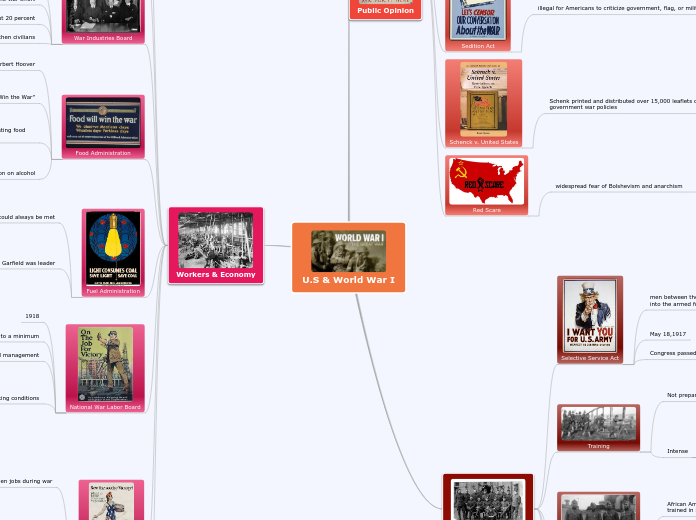
U.S & World War I

Public Opinion

Committee on Public Information
George Creel heads the CPI
created propaganda to influence opinions
made Americans support the war effort
made Americans anti-German everything
created a stigma around American Germans
German language stopped being taught
changed sauerkraut to be "liberty cabagge"
some violence and discrimination resulted

Espionage Act
punished people for aiding the enemy or refusing military duty
1917

Sedition Act
illegal for Americans to criticize government, flag, or military
over 1,000 people jailed over these laws
many citizens believed this violated the 1st amendment

Schenck v. United States
Schenk printed and distributed over 15,000 leaflets opposing government war policies
Argued the conviction as a violation of constitutional rights to free speech
Supreme Court upheld Schenck's conviction

Red Scare
widespread fear of Bolshevism and anarchism
because of Russian Revolution
Bolsheviks rebelled against territory within their own country

The Military

Selective Service Act
men between the ages of 21 and 30 to register to be drafted into the armed forces
Many men volunteered
Some men wanted to be conscientious objectors
These men faced prison when their requests were rejected
May 18,1917
Congress passed

Training
Not prepared
soldiers slept in tents
supplies were not readily available
Intense
soldiers spent days learning military rules and practices
practiced with wooden sticks
pretended to ride wooden barrels

Segregation
African Americans soldiers were segregated into divisions and trained in separate camps
only a few black men were trained for combat with guns
Latinos assigned menial tasks instead of combat

Women
serve overseas as switchboard operators
kept communications open between front lines and headquarters of the army
nurses
navy or marines
bookkeepers or typists

Fighting
Battle of Belleau Wood
8,000 causualties
America's bloodiest battle
June 1918
Second Battle of the Marne
July 15,1918
U.S blew up every bridge the Germans had built across the Marne
Germans retreated on August 3
suffered around 150,000 casualties

Workers & Economy

War Revenue Act of 1917
very high taxes and taxed the wealthiest Americans as much as 77% of annual income
increased federal revenues by 400 percent within two years

Liberty Bonds
a loan from American people to federal government
government needed to borrow money from civilians to pay for the war
sparked national debt to increase
more than $20 billion of U.S debt was owed to Americans

War Industries Board
led by Bernard Baruch
Wall Street businessman
authority to regulate all materials needed in the war effort
increased American industrial production by about 20 percent
military first, then civilians

Food Administration
led by Herbert Hoover
"Food Can Win the War"
"meatless Mondays"
"Wheatless Wednesdays"
increase the production of crops and conserve existing food supplies for the military and Allies
prohibition on alcohol
18th Amendment
banning the "manufacture, sale, or transportation" of alcohol in the U.S
1919

Fuel Administration
make sure the military needs for fuel could always be met
Harry Garfield was leader
introduced daylight savings time
extend daylight hours for those who worked long shifts in the factories
"gasless Sundays"
"heatless Mondays"

National War Labor Board
1918
kept disruptions to a minimum
judged disputes between workers and management
about 1,200 cases resolved, including 700,000 workers
set policies that improved working conditions
8 hour work day
suported labor unions
equal pay for women

Women's War Efforts
took on traditional men jobs during war
built railroads
docks
factories
built ships and airplanes
took on traditional women jobs
teachers
nurses
volunteer positions to help sell bonds
about 1 million women entered the workforce during WWI
many left jobs after war ended

Great Migration
1916-1970
African Americans moved from rural South to Northern cities
over 6 million
